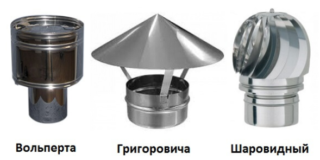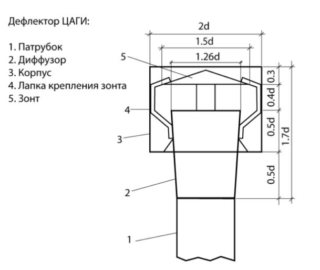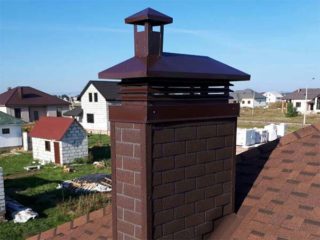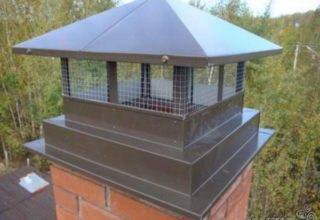The protective function for the pipe is performed by the cap. This is an element made of metal, which is placed in the upper part of the chimney. It protects the pipe from destruction by precipitation, from the entry of debris or birds, and also performs a decorative function. There is still debate about the need to install such a device. To choose the right cap for the pipe, you should familiarize yourself with their varieties. Also, a protective device can be made by yourself.
The main functions of the cap
A special metal product, called a cap on the chimney pipe, is designed to protect the outlet from the negative effects of atmospheric conditions. It should not interfere with traction, distort the conditions of movement of air masses. The presence or absence of such an element is provided for in the initial stages of designing a heating system. Installation is carried out in accordance with GOST and industry documents.
The cap performs the following functions:
- Closing the output from wind blowing. The direction of the air masses is constantly changing, therefore, to prevent the appearance of reverse thrust, a protective visor is placed.
- Protection against rain and snow, mechanical pollution, birds. The visor itself protects from atmospheric precipitation. In order not to get inside the bird, a net is placed. Over time, frozen condensate may form on it, due to which traction decreases. In addition, in winter, icicles form on the grid. It is necessary to pre-select the material on which moisture will not form.
- Extending the life of the head. Since the cap protects the pipe from debris and dirt, its inside will not be damaged. This will extend the operating time.
- Decor Original caps can improve the appearance of the house and emphasize the style of the building.
When installing the hood, it is important to consider the system so that the element does not interfere with the free exit of smoke. Otherwise, from a decorative visor there will only be harm and a threat to fire safety.
Despite all the functions of the hood, some experts are against their installation. This is due to the fact that the fungus interferes with the release of combustion products. The pipe umbrella then reduces traction. Also, during combustion, water vapor is released, which deposits on the metal. In cold weather, icicles form that block the cross section of the chimney. As a result, the waste can go into the house and poison the residents.
Modern round chimneys do not have a place for nesting birds. On such models, the installation of a protective copper mesh is not required. Properly constructed chimney channels have a condensate collector at the bottom. Precipitation in the form of water falls into it, which can then be removed.
Hood design
On sale you can find a large number of diverse models that differ in functionality, size, type of material used, external data. But they all have the required elements in their design.
- Umbrella or cap itself. In fact, this is the roof of the chimney, performing a protective function.
- Dropper apron. Such an element is present in brick chimneys. Required to drain condensate away from the pipe. Keeps the structure dry for a long time.
- Bracket. It is necessary to raise and hold the hood over the chimney. The number of clamps depends on the size of the shelter, its mass and design decision.
- Stingrays. They are placed only on complex designs.They allow you to increase the size of the product and complement its appearance.
All caps vary in appearance. Each specialist can himself design the visor on the pipe, but it is recommended to start manufacturing with the creation of the simplest design. Only after calculating all the parameters and operational characteristics can you make changes to the finished device.
Varieties of security elements
 Products to protect the chimney from atmospheric precipitation and debris are different in appearance.
Products to protect the chimney from atmospheric precipitation and debris are different in appearance.
The cross section of the pipe emit:
- round;
- rectangular;
- square.
The most common designs include:
- Models in the form of houses. They have a gable roof.
- Gable roof houses.
- Smokers with a semicircular and conical roof.
- Flat umbrellas.
Additional elements can be attached to the chimney cap. This can be a spark arrester, weather vane, ornaments, figures (skates, birds) and other decorative details.
Selection recommendations
The main function of the hood is to protect the chimney, so the appearance and shape can be any. It is important that the product fits the pipe in size. The fungus should not interfere with ventilation and the removal of smoke from the room.
Typically, pipes with four slopes are installed on brick pipes. On round chimneys it is better to put smoke chambers with a cone.
The overhang of the umbrella should protrude a few centimeters on each side of the pipe. This will further protect the chimney from rain and foliage. To protect against birds, a net is placed under an umbrella. Its functions can be performed by openwork forging, which will decorate the appearance.
If a wood-burning stove is used in the house, it is better not to choose a painted smoke box. Paint from it quickly burns out under the influence of smoke. It is better to take the heads with a sealed double cover. For ease of cleaning, they put heads with a hinged lid. When installing a gas boiler in the house, you can put colored caps.
Main materials
To create protection for the pipe, different metals are used. They must be reliable, strong, not responsive to external environmental influences and not reduce exhaust force. Such materials include galvanized steel, stainless steel and copper.
Protection made of galvanized steel is well tolerated by aggressive environmental influences and is distinguished by its practicality. Galvanized steel does not lose its color under direct sunlight. It can additionally be coated with a colored polymer - polyester. If a cap made of galvanized steel with a small thickness is placed, it can burn out after 3-5 years of constant use. High temperature gases destroy it, therefore it is recommended to install a stainless steel reflector. The cost of the device will be higher, but the service life will increase by several tens of years.
Materials of a higher class include stainless steel. It is characterized by durability and high strength. Its cost is higher than galvanized steel. It can be used as an additional protective element of the hood.
Copper caps are considered the most profitable. They have a long service life which reaches 100 years. Copper goes well with gutters and other elements, and also does not lose its attractive appearance over time. Making a hood on a chimney made of copper sheets is easier and more convenient. For work, a copper sheet with a thickness of 0.5 mm is selected. It is harder to work with them than with thin ones, but the stability of the assembled structure will be higher.
Self-made cap
 Assembling the visor on the chimney pipe begins with the selection of materials. You can use galvanized steel, but it is better to take copper. It is quickly covered with a protective film of oxides, after which it ceases to respond to the harmful effects of aggressive chemicals that are in the smoke. Recommended thickness is 0.6 mm.A thinner sheet does not have sufficient mechanical strength and is prone to deformation. It is also necessary to prepare a square, an awl, scissors for metal and a metal ruler.
Assembling the visor on the chimney pipe begins with the selection of materials. You can use galvanized steel, but it is better to take copper. It is quickly covered with a protective film of oxides, after which it ceases to respond to the harmful effects of aggressive chemicals that are in the smoke. Recommended thickness is 0.6 mm.A thinner sheet does not have sufficient mechanical strength and is prone to deformation. It is also necessary to prepare a square, an awl, scissors for metal and a metal ruler.
Next, you can begin to create a drawing, cutting parts and final assembly. But before you make an umbrella on the pipe with your own hands, you should calculate the dimensions and diameter of the chimney.
Parts preparation
First of all, it is necessary to measure the tip on which the visor will be mounted. The dimensions of the product should be 10 cm larger than the diameter of the pipe. There should be a 50 mm protrusion on all sides. The slope angle of the slopes varies in the range from 30 ° to 45 °. The minimum height from the cut to the visor must be 100 mm.
After measuring the dimensions, you can begin to create a sketch. It must be drawn on a piece of paper. It is better to take the simplest basic model and make corrections to it according to linear dimensions.
Next, the details of the visor for the chimney pipe are transferred to the copper sheet. When transferring the contours, leave 0.5 cm to the loopback. For convenience, the copper sheet can be cut into several parts and each draw its own details. You can draw on copper with a special felt-tip pen or awl. It is better to use the second option, since the lines in this case will be thinner and you will not have to remove traces of the marker.
Planned parts are easy to cut with metal scissors. If there is special equipment, you can perform cutting plasma cutting.
Bending parts and cap assembly
To properly bend parts, it is recommended to practice on unnecessary sheets of metal. In the case of experience and skills, it is not necessary to carry out the training; you can immediately assemble the cap on the chimney.
Bending of parts begins with a loop of edges. This can be done manually or on special equipment. The quality on the machine will be better, the execution speed is higher, but not everyone has the opportunity to purchase professional tools.
After the loop, the first part of the base is made. An additional lower bend will provide high strength. Angles must be bent to the dimensions indicated on the drawing and controlled by a protractor. If the work is performed on the machine, you can select specific templates. The bending technology in this case will not affect the operation algorithm. On the basis of rolling should be done, which will add stability to the structure.
Next, the base of the cap is assembled on a brick pipe. For work, special pliers will be required. With their help, you need to separate the mounting parts in different directions and assemble the elements in a single design.
Sliced and bent workpieces should be laid out on a flat surface. All sizes, bends and angles must be double-checked. With the help of ticks, it is necessary to bend the ends and collect all the details. It is important to perform the work carefully without damaging the front part. Locks do not need to be closed yet, they should only be prepared.
After a thorough check, you can close the locks with the blows of a mallet. This completes the assembly of the base, you can begin to create an umbrella for the chimney.
Making the roof of the chimney hood
The algorithm for creating a hood roof is similar to work on preparing the base. Similarly, all parts from the template are transferred to the metal. Each element must have an end for hem. Its length is selected based on convenience. It is important to remember that the length of the upper hem should be twice as long as the lower retainer. Dimensions must be selected so that as little metal as possible goes into the scrap. Recommended issues on triangular slopes are 30 mm, on trapezoidal 15 mm.
Billets are cut with metal scissors. For small elements, depending on the side of the bend, a different tool is selected - left or right.
After cutting, parts are bent.When they are ready to connect, you should lay out the elements on the table and double-check the dimensions and angles. It is necessary to roll stiffeners in the middle of the plane of the profiled sheet of copper and bend at the bottom. It will improve the strength and stability of the cap.
Next, the final assembly of the umbrella is performed. All connecting elements must be combined with each other along the lines. On the trapezoidal slopes are triangular and connected in a fold. Bending should be done with maximum effort so that the elements do not move after installation. Next, you need to make and attach the legs. They can be made from the remains of a copper sheet.
The width of the legs should be approximately 110-150 mm, leave 25 mm for the loopback. Dimensions may vary depending on the parameters of the segments. Scheduled parts are cut and bent. It is necessary to drill holes for rivets, which will be made through two layers of copper.
The roof, base and legs come together. If bird protection is provided, a copper mesh should be provided. It is fixed on special corners. The roof is mounted on rivets.







